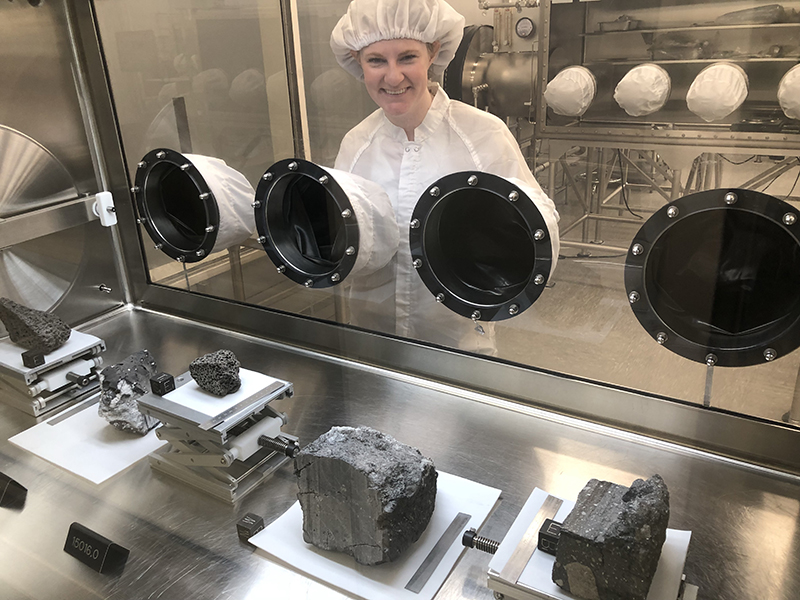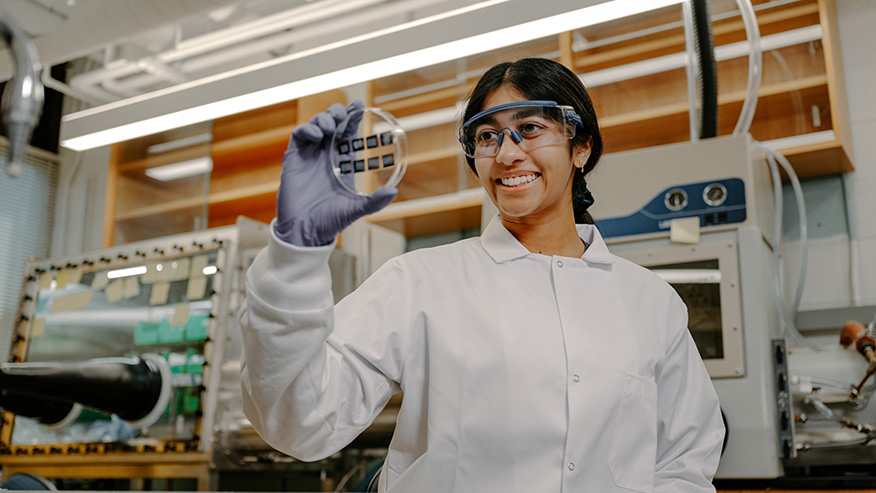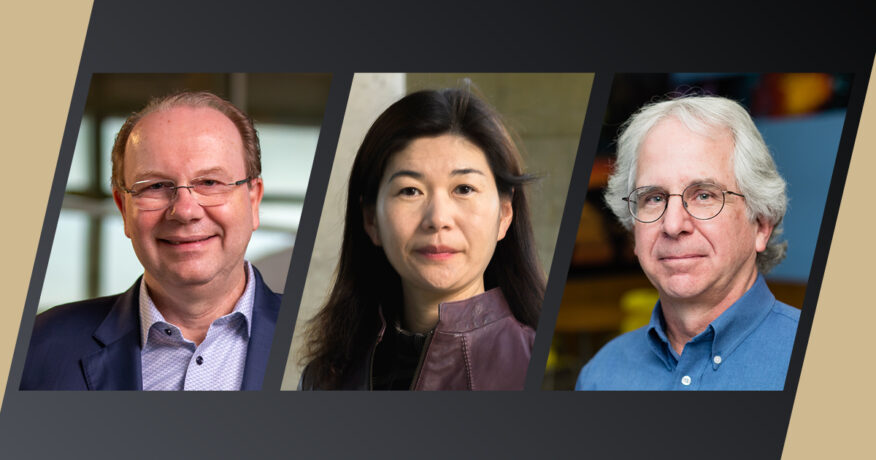This solar system rocks
Geologist studies asteroids and moondust to decode the history of the solar system

Michelle Thompson studies the moon, including samples from the last Apollo mission 50 years ago, and asteroids to understand the history and diversity of the solar system. (Purdue University photo/courtesy Michelle Thompson)
WEST LAFAYETTE, Ind. —
Michelle Thompson is a geologist. But while “geo” means earth, she studies things that are decidedly unearthly, or at least extraterrestrial: the moon and asteroids.
“I study space weathering: how space environments affect tiny mineral particles on planetary surfaces,” said Thompson, an assistant professor in the Department of Earth, Atmospheric, and Planetary Sciences in Purdue University’s College of Science. “We can learn so much from those minuscule samples; we can learn about the evolution of planets and moons — including our own. More broadly, we study these tiny samples and can extrapolate the history of the solar system.”
Moon shot
As humans gear up to go back to the moon, scientists are keenly aware that the last human to leave a bootprint on the lunar surface departed 50 years ago, when Apollo 17 began its journey home on December 14, 1972.
The astronauts on the surface during that trip, Purdue alumnus Eugene Cernan and Harrison “Jack” Schmitt, collected moon rocks and dust that scientists, including Thompson, are just now beginning to analyze through the Apollo Next Generation Sample Analysis Program.
“It’s amazing, it’s surreal, to be standing in a lab at Purdue analyzing moondust collected by another Purdue alum — the last person to walk on the moon,” Thompson said.
The research is possible only because much of the more than 840 pounds of moon rocks and dust has been kept sacrosanct for nearly half a century. Now scientists believe they have even better tools that are more sensitive, allowing them to comprehensively study the samples and answer questions that were impossible to explore 50 years ago.
Thompson is an expert in the way rocks interact with and change due to their exposure to the vacuum of space — a phenomenon called space weathering. Analyzing the chemistry of moon rocks and moondust can tell her about the environment, evolution and history of the moon.
A lunar core sample, a small column of moondust extracted from the lunar surface by Cernan and Schmitt, the first and only geologist ever to walk on the moon, gives Thompson and her lab those insights. It comes from a part of the moon that may have experienced an avalanche, providing even deeper insight into the distribution of minerals and the chemistry of the moon and the processes that shape its surface. Thompson is hoping that her research team will be able to understand what the moon’s surface was like before and after the avalanche, gaining greater knowledge of how its soil, or regolith, has developed over time.
“When these samples were collected, when men walked on the moon, I hadn’t even been born,” Thompson said. “This sample has been on Earth longer than I have. It has been sitting in storage, kept pristine, waiting for scientists to analyze it since it was returned. Scientists now have tools and technologies that the original generation of astronauts could only dream of. So now it’s our turn to follow in their footsteps and study the moon rocks they brought back.”
Future moon missions — including Artemis — will bring back new samples, and new techniques will continue to shed light on the moon for geologists like Thompson.
Time capsules from space
It is counterintuitive, but one of the best ways to study how Earth formed is by looking at rocks that come from almost anywhere else.
“Asteroids are windows into the very early solar system; they’re relics,” Thompson said. “They are time machines that show us what the building blocks were for the early solar system, what the building blocks were for life on Earth. Studying these asteroids gives us the recipe for the early solar system and what early organic molecules may have seeded life on Earth.”
Millions of meteorites and thousands of asteroids, including the Lafayette meteorite, a rocky body discovered at Purdue that is actually a broken-off piece of Mars, have hit Earth. However, studying those, while interesting, can’t answer the same questions as asteroids from space can.
Even a short interaction with Earth’s atmosphere, biosphere and minerals contaminates meteorites and asteroids and makes them harder to study. To get pristine material and determine the history of these space rocks, and the solar system’s history, scientists need to intercept rocks — asteroids — in space. Scientists can study the asteroid and determine where it formed in the solar system, what other bodies it might have come into contact with (or come from), and what its evolution may have been like.
In her lab right now, Thompson has tiny fragments of one of the first asteroids ever sampled in space and ferried to terrestrial laboratories: the asteroid Ryugu, sampled by the Japanese spacecraft Hayabusa2 during the first mission to operate rovers on an asteroid. The Japan Aerospace Exploration Agency launched the mission in 2014. The spacecraft reached Ryugu in 2018 and deployed its rovers. In 2019 it fired what was essentially an anti-tank missile at the surface of the asteroid to collect subsurface samples. Those samples landed on Earth in 2020 and were made available to NASA scientists, including Thompson. Studying asteroids, and comparing and contrasting them with the surface of the moon, gives scientists a better understanding of the origins and diversity of bodies in the solar system.
Tiger team
Next year, the adventure gets even bigger. Thompson is part of the “tiger team” — an elite squad of experts — in meteorite studies for NASA’s mission OSIRIS-REx to the asteroid Bennu. NASA deployed a tiger team to bring the Apollo 13 crew home. OSIRIS-REx (or the Origins, Spectral Interpretation, Resource Identification, Security-Regolith Explorer) will bring rock samples, not beleaguered astronauts, to Earth. The samples will land in Utah and then be flown to secure clean labs in Texas. Thompson will be among the first humans — and the first woman — to study the pieces of Bennu. She and the four other members of the tiger team will have 72 hours to study the asteroid sample and prepare a preliminary report for NASA.
OSIRIS-REx used two different techniques to collect samples from the asteroid. A sort of robot vacuum sucked in a lot of the material from the surface — likely far more than 60 grams, which was the minimum the scientists hoped for.
The second method involved gently and passively collecting samples at the surface.
“When the spacecraft touched the surface of the asteroid, it landed on these small circular pads, a lot like Velcro, which trapped material right at the surface of the asteroid,” said Thompson. “We call them contact pads. The little motes of dust, the dust particles, are stuck in the Velcro. We’re studying those tiny dust particles. All the stuff I’m interested in is surface processes, what’s happening to the very top material.”
Writer/Media contact: Brittany Steff, bsteff@purdue.edu
Source: Michelle Thompson



